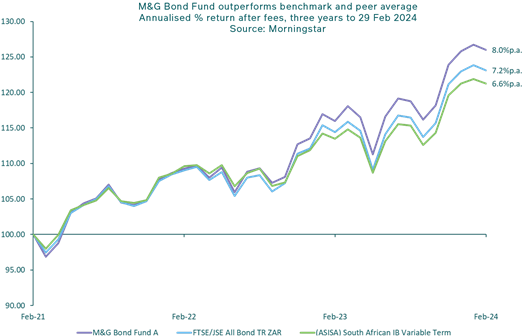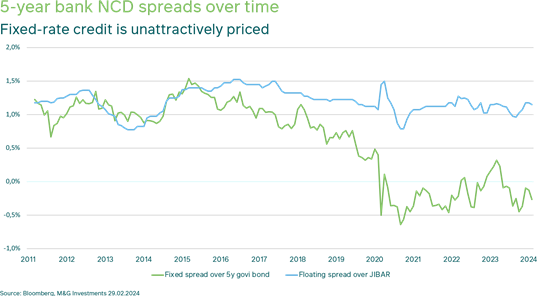M&G Bond Fund offers consistent, diversified outperformance
It has been approximately two years since the Fixed Income team at M&G Investments fully adjusted our investment approach in managing the M&G Bond Fund, in response to several significant changes in the South African bond market. These conditions made it increasingly difficult for all local bond fund managers to produce returns that beat the FTSE/JSE All Bond Index (ALBI) using traditional management methods – and continue to do so – and we consequently turned to a less orthodox investment method to generate market-beating returns for our clients. The result? The fund’s recent nominations for both the Raging Bull and Morningstar Awards* for best performance in its category suggest that these changes are paying off.
As the graph shows, the fund (in purple) has significantly outperformed the ALBI (in blue) over the three-year period. Pleasingly, it ranked #4 out of 51 funds in the ASISA SA IB Variable term category over one year, #4 out of 41 funds over two years, and #3 out of 37 funds over three years to end 2023. And this has been delivered amid exceptionally volatile conditions in the global bond market. Meanwhile, the graph also highlights how the average SA bond fund (in green) has not been able to meaningfully beat the ALBI over three years.

A diversified source of alpha from bonds
What is also important for investors to note is that this outperformance (or alpha) has not been generated by taking higher credit risk or higher duration risk than the ALBI, which is common among South African bond fund managers, but primarily through successful, active “stock-picking” along the South African yield curve using a relative value framework. This is a somewhat unorthodox approach that is, in our opinion, rare among South African managers. The advantages are numerous, however.
- Using a relative value or “curve positioning” approach means that returns are less impacted by the unpredictable interest rate cycle, and investors do not need to have a specific view on the direction of interest rates.
- The very low level of credit exposure means returns are less likely to be impacted by default-related losses from higher-risk credit.
The M&G Bond Fund can act as an effective diversifier for investors wanting the stable and growing income provided by bonds, either on its own or combined with other bond funds in a fixed income portfolio.
How does the fund differ from other South African bond funds?
Theoretically, an active bond fund manager can employ three primary “levers” in an attempt to outperform the FTSE/JSE All Bond Index:
1. Taking credit risk: This involves holding more fixed-rate corporate credit exposure than the benchmark. As corporate bonds expose investors to a higher risk of default, these bonds would normally pay higher yields than those on similar government bonds as compensation.
2. Taking duration risk: This means holding views on the level and future direction of bond yield moves as interest rates change over time, and involves positioning a portfolio to be more or less sensitive to yield moves (commonly referred to as a fund’s “duration” positioning).
3. Curve positioning or relative value: This involves taking positions on the shape of the yield curve (or “stock picking”) by identifying mis-pricing opportunities in different bonds in absolute terms and relative to each other. The managers look for tactical opportunities to concentrate the portfolio in certain parts of the yield curve where analysis shows the best risk-adjusted returns are likely to be generated.
At M&G Investments we have always sought to actively use all these levers to generate returns for our clients, with market conditions, valuations and relative opportunities dictating the extent to which we employ each ‘lever’ in the fund to ensure we can meet the fund’s investment objective.
Over the years, returns from credit (fixed-rate corporate bond) holdings were a significant driver of the fund’s performance. The exposure to credit in the fund peaked following the 2008 Global Financial Crisis (GFC) at nearly 70% of the fund’s holdings as it looked to take advantage of the substantially elevated yields on offer on the back of the market’s risk-aversion post the crisis. However, the GFC heralded the end of the strong growth in the local credit market, largely due to the much higher levels of compensation investors started to demand.
Credit opportunities dwindle
Subsequently, credit exposure declined steadily as attractive investment opportunities in the domestic credit market diminished due to a combination of a lack of fixed-rate issuance (in particular a lack of new corporate issuers) and insufficient yields on fixed-rate credit (in our opinion) to compensate investors for the risk involved – and we have commented on these aspects frequently over a number of years. As an example, in 2015 an investor could buy a fixed-rate bond issued by a bank at a yield of more than 1.5% above the equivalent government bond. Today, as the graph illustrates, the same bond would pay around 0.26% less than the equivalent government bond! With higher-risk fixed-rate debt broadly not having offering appropriate compensation since 2016, we have actively reduced the fund’s credit exposure steadily to zero. Today only the significantly riskier issuers have bonds that yield more than government bonds, risk we have deemed not worth taking.

Instead, we tilted the fund towards the other two levers to drive performance to a greater extent, and both duration and curve positioning were significant return drivers following the GFC. However, duration positioning proved to be very volatile as global bond market volatility rose. Traditionally it has a “lumpy” return profile compared to the more constant return profile that credit tends to deliver (assuming you avoid defaults). It is also a source of return that is more at risk from macro events that are difficult, if not impossible, to foresee, such as the infamous ‘Nenegate’ or Covid-19 downturns.
Risk that is well-rewarded
Curve positioning, on the other hand, allows the fund managers to exploit relative mis-pricings along the yield curve without necessarily exposing the fund to changing absolute levels of the yield curve. This is key because one does not need to have a view on the path of interest rates. Our ultimate aim with this approach is to build a portfolio of bonds with exposure to risk that is well-rewarded and agnostic to the interest rate cycle. Over the last three years, we have found that our active yield curve positioning based on relative value, combined with neutral duration positioning among other refinements, has been the most successful way to manage the M&G Bond Fund to deliver a superior return for the risk involved.
Meanwhile, as far as we can see, other local bond fund managers continue to rely on credit risk exposure and duration positioning as their main levers of outperformance. However, few have succeeded in beating the ALBI given the scarcity of higher-yielding credit, as evidenced by the ASISA statistics. In M&G’s view, these two options currently introduce unnecessary risk to our portfolios – we will not chase poor quality debt in the hopes of generating a higher return. Nor will we hold unlisted bonds or structured notes that can obfuscate the credit quality of the instrument. This does not mean that the M&G Bond Fund has a lower risk profile than its peers, however, it merely has a different type of risk.
Elevated real bond yields present an opportunity
With South African interest rates likely to have already peaked and to start to decline at some point in 2024, together with real bond yields now sitting at very attractive levels on an historic basis, investors are currently presented with an excellent opportunity to add domestic bond exposure to their portfolios. Those investors who may be holding significant exposure to cash, in particular, would do well to consider bonds instead. We believe the M&G Bond Fund is well-positioned to deliver benchmark-beating returns going forward, on top of the healthy returns expected from the bond market.
*Raging Bull 2024 nomination for “Best SA interest-bearing variable-term fund” for its straight performance over the three-year period to 31 December 2023; finalist for “Best Bond Fund” for risk-adjusted, multi-year performance to 31 December 2023 in the Morningstar Awards.
Share
Did you enjoy this article?
 South Africa
South Africa Namibia
Namibia




 Get the Newsletter
Get the Newsletter